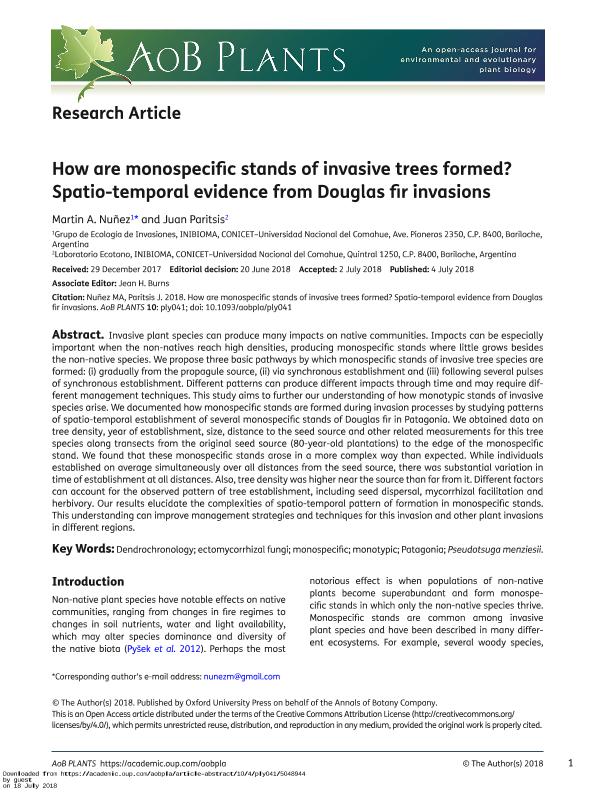Artículo
How are monospecific stands of invasive trees formed? Spatio-temporal evidence from Douglas fir invasions
Fecha de publicación:
04/07/2018
Editorial:
Oxford University Press
Revista:
AoB PLANTS
ISSN:
2041-2851
Idioma:
Inglés
Tipo de recurso:
Artículo publicado
Clasificación temática:
Resumen
Invasive plant species can produce many impacts on native communities. Impacts can be especially important when the non-natives reach high densities, producing monospecific stands where little grows besides the non-native species. We propose three basic pathways by which monospecific stands of invasive tree species are formed: (i) gradually from the propagule source, (ii) via synchronous establishment and (iii) following several pulses of synchronous establishment. Different patterns can produce different impacts through time and may require different management techniques. This study aims to further our understanding of how monotypic stands of invasive species arise. We documented how monospecific stands are formed during invasion processes by studying patterns of spatio-temporal establishment of several monospecific stands of Douglas fir in Patagonia. We obtained data on tree density, year of establishment, size, distance to the seed source and other related measurements for this tree species along transects from the original seed source (80-year-old plantations) to the edge of the monospecific stand. We found that these monospecific stands arose in a more complex way than expected. While individuals established on average simultaneously over all distances from the seed source, there was substantial variation in time of establishment at all distances. Also, tree density was higher near the source than far from it. Different factors can account for the observed pattern of tree establishment, including seed dispersal, mycorrhizal facilitation and herbivory. Our results elucidate the complexities of spatio-temporal pattern of formation in monospecific stands. This understanding can improve management strategies and techniques for this invasion and other plant invasions in different regions.
Archivos asociados
Licencia
Identificadores
Colecciones
Articulos(INIBIOMA)
Articulos de INST. DE INVEST.EN BIODIVERSIDAD Y MEDIOAMBIENTE
Articulos de INST. DE INVEST.EN BIODIVERSIDAD Y MEDIOAMBIENTE
Citación
Nuñez, Martin Andres; Paritsis, Juan; How are monospecific stands of invasive trees formed? Spatio-temporal evidence from Douglas fir invasions; Oxford University Press; AoB PLANTS; 10; 4; 4-7-2018; 1-10
Compartir
Altmétricas




